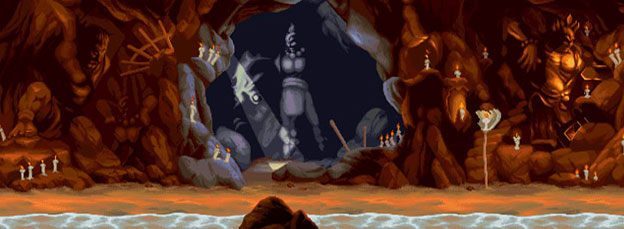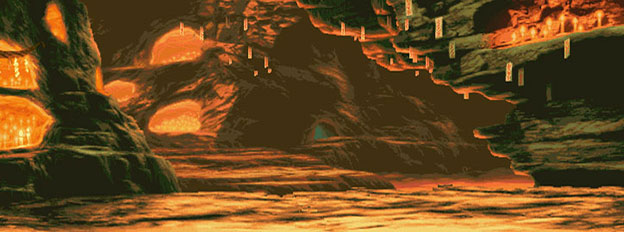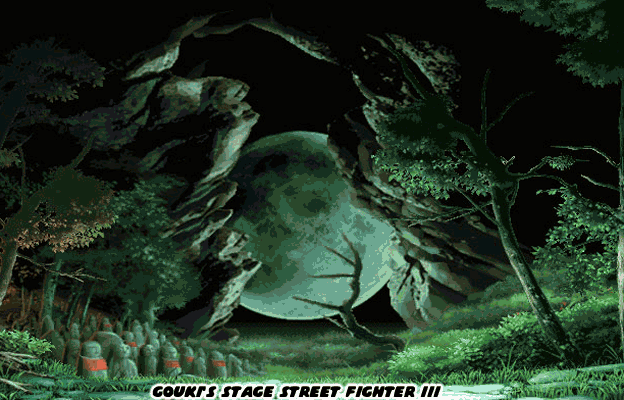Gouki was a hermit that seemed to live within a cave. These caves were often decorated with votives and powerful symbols. The Nio that Gouki emulated were carved into the walls of the caves. Whether he had come across an ancient temple or whether he had carved these figures himself was never explained. Either interpretation said a lot about the character. This open inference that Capcom allowed of their characters, their thoughts and desires always made them unique. Other fighting games often presented a fixed take on the characters which followed them through canon. Each designer of Street Fighter was allowed to interpret the world as they saw it. This meant that the canon between the original Street Fighter and Street Fighter IV was nebulous at best. Each character had a small piece of a bigger puzzle. Even if players were familiar with all of the stories from every sequel none of the pieces seemed to fit perfectly together. This could be maddening for some and cause heated debates on several gaming boards as to the "true" canon of Street Fighter.

For Gouki the mystery surrounding his stage helped make the character more unique. As the character was fleshed out between Super Street Fighter II Turbo, Street Fighter Zero and Street Fighter III his stages became more imposing. The designers and artists slowly weaned the levels off of bold Asian religious icons and began to put in elements that were more universally recognized. The stages that Gouki called home still had spiritual connotations. To gamers in the West the exact origins did not have to be known in order to be understood. Players that had been following the series were familiar with the dark secretive levels that Gouki appeared on. As the series progressed the player seemed to progress deeper and deeper into a cave. The only light in the stages came from candlelight. They cast an eerie glow on the level. The candles seemed limitless, tucked in the darkest recesses of the cave by an unseen hand. The colors given off by the candles gave the cave in a myriad of hues, some cold and others hellish. The end result was the same. By advancing into the world of Gouki the player had left behind the mortal world. The stages were meant to invoke images of the afterlife. Gouki was no longer seeking opponents. He let those foolish enough to seek him out do so. Players symbolically descended into Hell to face the demon himself. Perhaps they did not really cross over but were at the very least standing at the Gates which he guarded. A person that lost a fight down there would remain there for all time.
Most Japanese audiences could pick out the details on these ethereal stages. They could see Shinto symbols in several of the levels. None were more profound than the use of the rope or Shimenawa. Ropes were used to bind spirits, called Kami, into objects like rocks or trees in Shinto spiritual beliefs. The objects that attracted kami were known as Yorishiro. When the ropes were adorned with paper streamers called shide they marked the spiritual sacredness of the location or object. Throughout Japan there were trees and even islands bound by shimenawa and shide. Street Fighter, Samurai Spirits and a few other Japanese developed games often made use of shinto iconography. The unique thing for the spiritual belief was that kami could not only possess natural objects but also people as well. A Yorimashi or "Possessed Person" was a person that took the place of a Yoshiro. The rope belt that Gouki wore, instead of the cloth belt worn by traditional karate masters, would be a way for him to symbolically bind the kami to his body. The prayer beads he wore would be a way to keep the spirits under his control and not vice-versa. When Gouki would go crazy in the comic stories his prayer beads would break and scatter. Gouki would not longer be aware of himself as the Dark Hadou had completely taken over.

This layering of spiritual themes made Gouki a much more profound character, especially to Asians. Previously gamers in the West thought he was just a cool-looking martial arts master but the more they learned about him the more unique he became. Despite all of the supernatural elements Capcom still managed to ground him in reality. Gouki was amazingly strong and powerful, but real martial artists had demonstrated that they too could kill man and animal alike with a single punch. What made Gouki dangerous was his lack of empathy for life. He would not give a second thought to murdering any person or animal. This was what made the man dangerous. His obsession was power and his objective was to be the greatest fighter ever. Past that he had no other purpose. His life was devoid of humanity and this was what turned Gouki into a monster.
Players that entered a battle against the character knew they were in for something special. The time and the place for each encounter was carefully crafted by the artisans at Capcom. The mystique surrounding Gouki would have been lost if his stage was in the middle of Times Square. The bright lights and traffic of a metropolis would have made the character appear absurd. Instead players seemed to face him in underground caves or secret temples. Always at the middle of the night and during the full moon. Or worse yet, during the Blood Moon aka the Hunter's Moon. This was the first full moon after the Harvest Moon, signaling the end of the growing cycle and the beginning to the sleep cycle for nature. In some cultures it was also the death cycle. The illuminated stage, whether by candlelight or moonlight made shadows dance in the dark corners of the screen. Gamers had to take a second glance at the background to make sure the levels weren't looking back. The stages were often devoid of life. As if the creatures of the forest had abandoned their homes.

Capcom had learned that the most effective characters included elements from the real world. The most effective villains were believable even when they demonstrated supernatural origins and powers. Their stages painted a sinister picture on an animated canvas. The purpose of the most evil characters was clearly conveyed to audiences. Capcom needed to learn that they could apply similar lessons to characters from other nations. SNK had taken a step forward in that regard. Silber was a unique German, whose monstrous appearance harkened back to old-world mythologies and the villains from fairy tales. He replaced the previously all-Japanese karate masters in fighting games. With these lessons observed the minority characters that left behind stereotypes and embraced an actual African or Afro-Caribbean heritage were much more interesting. They did not need to be presented on a dance floor or in front of a basketball court so audiences would get that they were "black." It would be possible to combine the lessons learned from characters like Gouki and Silber and create a powerful but believable black villain in a fighting game. The next blog will look at this in detail. As always if you enjoyed this blog and would like to sponsor me please visit my Patreon page and consider donating each month, even as little as $1 would help make better blogs and even podcasts!

No comments:
Post a Comment